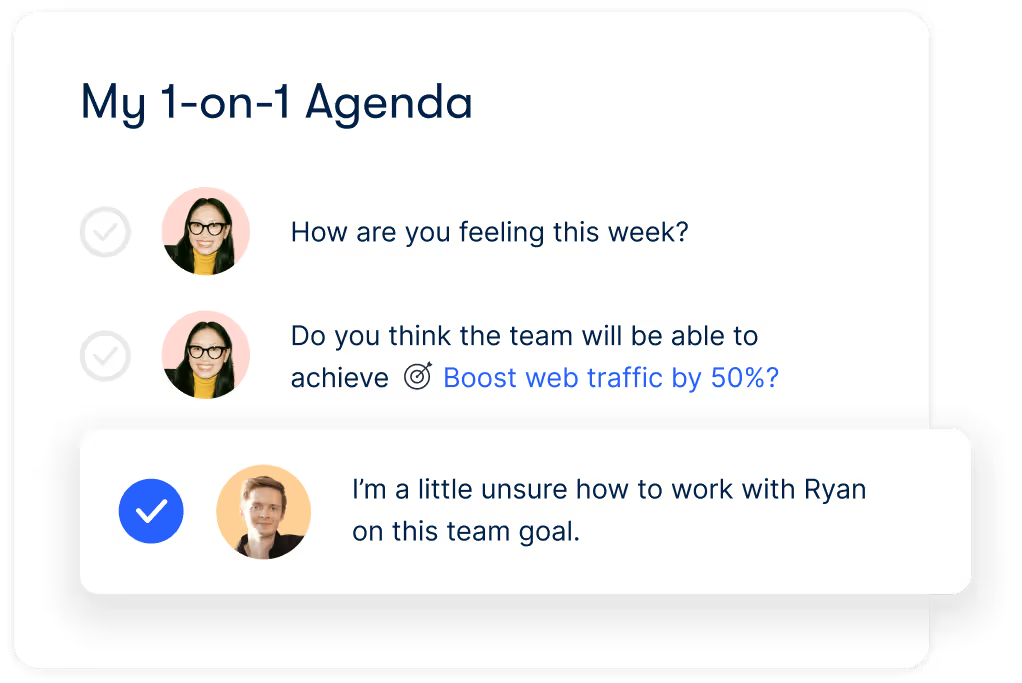What is the purpose of one-on-one meetings?

Discover Workleap Officevibe's benchmark report on 12 key employee engagement metrics

A one-on-one meeting is a type of meeting that happens between two people who work together. Generally, these important conversations happen between managers and each of their direct reports. The opportunity to connect in a one-on-one environment, versus a larger team meeting, is important and beneficial both for the employees and managers.
From discussing ongoing work to coaching performance and even working through interpersonal conflict, having moments for candid conversations at work has a whole host of benefits. But if you’ve never had a one-on-one, the concept might feel like a bit of a question mark. What should you talk about? How often should you have one-on-ones? What do you get out of these talks?
Ultimately, understanding the purpose of one-on-one meetings—and the specific purpose they hold for you—helps make this dedicated time productive and impactful.
What is a one-on-one meeting?
A one-on-one meeting is ultimately any meeting between two people in an organization. These meetings happen between peers, across departments, and within upper leadership. But most commonly, one-on-ones take place between an employee and their manager.
What is the purpose of one-on-one meetings?
There are a number of reasons for managers and employees to meet regularly. The purpose of your one-on-one meetings might change from week to week, month to month, or quarter to quarter. Here are some common one-on-one purposes:
Building and maintaining the manager-employee relationship
For managers and employees to work well together, there needs to be a baseline of trust, familiarity, and understanding. In other words, there needs to be a relationship. One-on-one meetings give both managers and employees the perfect opportunity to build, foster, and maintain that relationship. This can make for stronger communication and a more effective working environment.
Creating space for specific conversations
There are some conversations that aren’t appropriate to have during a team meeting or in front of other colleagues. A one-on-one conversation can offer a safe environment for employees to raise challenging, private, or personal matters. It’s also a place for managers to address employee concerns. These might be concerns that they don't feel comfortable sharing in front of the rest of the team.
Employee goal setting
One of a manager's most important tasks is fostering their employees’ career growth. To do that effectively, they need to understand each person's career goals and how they align with the team's objectives. One-on-one meetings create a dedicated time and space to set employee goals. And, a chance to follow their progress as they achieve their milestones.
Developing action plans
Helping each team member grow professionally and succeed in their role is a key part of management. Sometimes, employees will need a bit more coaching and a clear performance action plan to help them get there. This should be seen as an opportunity for support and development. One of the best ways to do this is have employees work together with their managers to develop a performance plan.
Giving and receiving honest feedback
Getting constructive feedback can help employees reach their full potential. Having someone at work who helps them continually improve and develop is crucial. On the other side, receiving feedback from employees helps managers to develop in their roles and better support their team. One-on-one meetings are a great moment for giving and receiving constructive feedback between managers and employees.
Factors to consider when defining your meeting purpose:
- Who is attending
- Team objectives and work
- The goal of the meeting
- What’s being discussed
- The current business context

Long term vs. short term goals for one-on-one meetings
Whatever the purpose of your one-on-ones, it’s important that both employees and managers walk away feeling like they accomplished what they set out to do. Setting one-on-one meeting goals helps you make sure you continue to fulfil your purpose together.
Short-term meeting goals are about what you want to accomplish before any single one-on-one meeting is over.
For example: If you're meeting to discuss an employee’s career trajectory, the manager's short-term goal might be to better understand where they see themselves growing in the company. On the other hand, the employee's short-term goal might be to ask about a new position opening up on the team.
Long-term meeting goals are about what you want to accomplish by meeting regularly in a one-on-one environment.
For example: A manager's long-term one-on-one goals might be to foster stronger relationships with their employees. An employee’s long-term goal might be to develop their skill set and gain their manager's trust, to become more autonomous in their role.
Getting the most out of one-on-one meetings
Here are some one-on-one meeting tips to make sure you're getting the most out of your time, and achieving your meeting purpose.
- Schedule regular one-on-one meetings. Recurring meetings are key for continuity. This could be a regular check-in at the end of each week, a monthly meetings to share status updates on the employee’s career progression plan, or a quarterly performance review meeting. Or, you could have all 3 types of meetings.
- Prepare one-on-one meeting questions. Questions are a great way to drive the conversation, whether it's the manager or employee asking them. Before your meeting, take the time to prepare a couple of relevant, open-ended questions related to your talking points.
- Take meeting notes and keep track of them. If you forget what you discussed during your meeting, you won’t be able to take action on your discussion. Take notes of the key takeaways from your meeting, and use them to follow up in your next conversation.
- Define action items and set next steps. At the end of your meeting, review your notes together and define at least one or two clear action items. These could be related to deliverables, deadlines, or follow-ups either of you are responsible for.
- Schedule a follow-up meeting. Before you wrap up your one-on-one, coordinate when you’re going to meet again to follow up on your action items. Set the date in your calendar and add some talking points for next time.
- When in doubt, use an agenda template. If you’re not sure how to navigate your meeting, using a one-on-one meeting template can help. This way, you make sure you cover all the points you want to, and save some preparation time.
Benefits of one on one meetings
The benefits of one-on-one meetings stretch across the entire organization. Everyone, from individual contributors to managers and leadership, has something to gain from effective one-on-one meetings.
Benefits for employees
Employees benefit from one-on-one meetings because it gives them a space where they have their supervisor’s undivided attention. This gives them a platform to discuss or explore anything that might help their career.
For example: Getting feedback on their performance or creating an action plan to land a promotion.
Benefits for managers
Managers benefit from one-on-ones because they keep them connected with their team members. And understanding how people feel and their challenges helps managers create tangible plans to give support both at an individual level and to their team as a whole.
For example: Spotting issues with employee engagement or budding team conflict, and being able to take action early.
Benefits for the business
For companies as a whole, one-on-one meetings create overarching alignment, nurture employee engagement, and develop team performance. This leads to increased productivity and efficiency in the workplace—all of which directly benefit the organization.
For example: Team members better understanding how they fit into their shared team objectives, and how that contributes to the business mission.
Bring a sense of purpose to every one-on-one meeting
Really understanding the benefits and impact of regular one-on-ones helps everyone make better use of this time. Ultimately, running more effective and productive one-on-one meetings lead to a more aligned, more connected workforce.
Give HR and managers the clarity, confidence, and connection to lead better every day.


%20(1).avif)


.avif)
.avif)








